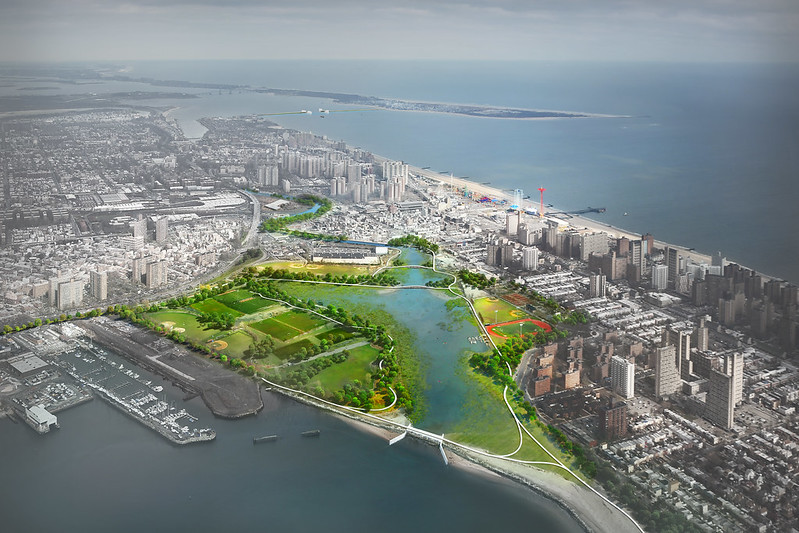
Climate resiliency envisioning (photo: mayor's office)
Superstorm Sandy’s impact on New York City must not be forgotten: 44 people died citywide, over 69,000 homes were damaged, and Brooklyn’s waterfront neighborhoods flooded in an area more than twice as large as the 100-year floodplain. Over 2 million New Yorkers lost power, stranding some residents – especially those in public housing – for weeks before power was restored.
Now it’s a decade later and we’re still recovering from the last storm and completely unprepared for the next one. We need to reinvigorate our recovery and resiliency efforts now, executing on investment opportunities, changing how we deliver on capital projects, and entirely rethinking how we build our city.
We have to start by understanding the status of our recovery and resiliency projects 10 years after Sandy struck our city, and we need not look further than New York City Comptroller Brad Lander’s extensive report published earlier this month.
The Comptroller demonstrates that the City has spent $11 billion, or 73%, of the $15 billion in federally-allocated grants appropriated for projects resulting from Sandy. He concedes that this is a bit of progress from 2019, when only 54% of these grants had been spent, but projects remain incomplete, with some not slated to be finished until as far out as 2030. Some projects are underinvested – only 0.3% of funding to raise shorelines has been spent, which would help protect neighborhoods such as Coney Island – and since the NYC Sandy Tracker only shows federal funds spent, the City’s own low capital contributions are concealed.
We’ve got to ramp up our investments at all levels of government, and this funding must be strategically targeted to ensure projects are generating the greatest possible protections for our communities. This means we need transparency. By implementing grant accounting procedures for federal funds and improving how we publicly track capital projects, we can empower leaders, advocates, and communities to ensure our spending is sufficient, sustained, and allocated correctly. At the same time, we have to strengthen the City’s ability to execute these projects on budget and on time.
First Deputy Mayor Lorraine Grillo’s Capital Process Reform Task Force has initial recommendations ready to go that would accelerate the pace of incomplete resiliency projects and future projects. We should implement those now if we’re going to successfully scale our transformative spending opportunities – like the $4.2 billion that the state’s Environmental Bond Act, if passed this November, would set aside to fund climate resiliency, natural protection, and clean energy projects while boosting the long-term security of funding for climate resiliency projects across our state.
But all this talk of money and project execution is nothing without the planning that will guide it. One of my main priorities as Brooklyn Borough President is to rethink how we approach our built environment through comprehensive planning.
Instead of piecemeal rezonings or scattered and inequitable development, we must zoom out and look at our city holistically. We should consider how development in one neighborhood may affect the others nearby, the way our environment informs the health of our residents and communities, and how our built and natural environments interact. Then, we build our city planning around this data and the deep understanding of where resources are abundant and where they’re needed.
To understand what this means in the context of climate change, we can look to our NYCHA public housing. Today, 17% of NYCHA’s buildings are in the 100-year floodplain, but by mid-century, this number will grow to 26% – one in every four NYCHA developments. Still to this day, Red Hook Houses is dealing with the consequences of Sandy, including issues with electricity, plumbing, and mold.
Our public housing residents deserve better, and we’re already confronting a housing crisis displacing far too many of our neighbors. This is where comprehensive planning comes in, requiring that our urgently needed new development is resilient and affordable, indicating where we do or don’t want to grow, and helping us to ensure that vulnerable populations aren’t being encouraged to move to at-risk areas like floodplains.
The recovery and resiliency of our public housing, as well as the risks facing our industrial and manufacturing facilities, neighborhood parks, and other essential infrastructure (a whopping 79% of our transportation and utility land uses that support everything from electric and gas utilities to railyards and airports are located in the floodplain), are challenges we have to solve now.
We don’t have the luxury of time – and a coordinated vision for the City’s future, tied to the City’s budget and grounded in interagency collaboration, would lead to the more efficient allocation of resources for the large-scale projects we require. Our short political cycles have hindered us from creating a long-term plan to deal with the reality of climate change, and the pressure is on. There is a better way.
***
Antonio Reynoso is Brooklyn Borough President. On Twitter @BKBPReynoso .
***
Have an op-ed idea or submission for Gotham Gazette? Email This email address is being protected from spambots. You need JavaScript enabled to view it.




